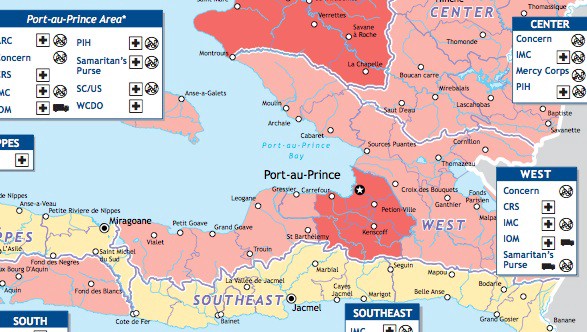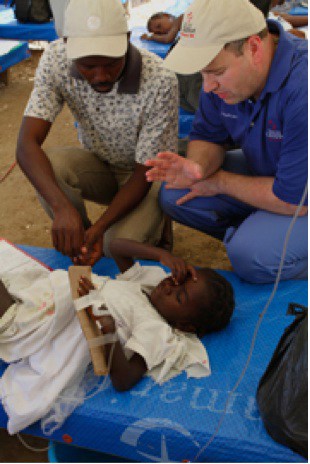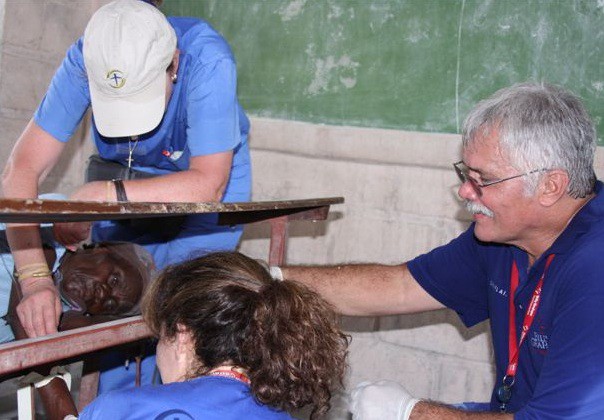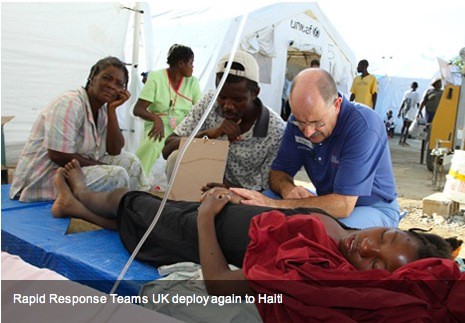U.S. Federal Funds Still Underwriting Proselytizing in Haiti
by Abe Sauer

On January 20th, we published the results of an investigation that proved the use of United States Agency for International Development funding in Haiti, in direct violation of executive orders. While we noted considerable evidence of Billy Graham Evangelistic Association (BGEA) chaplains proselytizing at USAID-funded Samaritan’s Purse cholera clinics, USAID dismissed the findings, attributing the abuse to “an individual” and noted that this NGO partner “is working to re-educate their staff about regulations pertaining to religious activities.”
The BGEA itself seems happy to sell this claim as well. A January 24th story about Graham’s organizations in the Charlotte Observer (later picked up by McClatchy Newspapers) noted, “Samaritan’s Purse recently responded to criticism by asking the chaplains to stop preaching at the cholera clinics because the effort is partially funded by government grants.” (That “criticism” was ours, by the way.)
Funny then that a February 4, 2011 dispatch from BGEA Rapid Response Team chaplain Andrew Hawkins should read: “Time spent this morning at the Cite Solielle CTC (Cholera Treatment Centre) was fruitful. We began praying from bed to bed for the women patients and one wanted to receive Christ.”
Yes. Further information reveals systematic misuse of USAID funding in Haiti by Samaritan’s Purse, and no abatement to that activity, even after USAID said otherwise.
Following our first story, both the BGEA and Samaritan’s Purse websites ceased publishing any dispatches from Haiti on the organizations’ works. Except, it appears nobody told their U.K. or Canadian offices.
Reports from the BGEA’s U.K. chapter on the work of “Rapid Response Team” chaplains in Samaritan’s Purse camps continue to pour in, long after their honcho Franklin Graham himself claimed that chaplains had stopped preaching at the cholera clinics. Dispatches from BGEA RRT chaplains Roger Abbott, Nigel Fawcett-Jones, Andrew Hawkins and Johnson Olajide between November 2010 and February 2011 confirm both that the relationship between BGEA and Samaritan’s Purse goes far beyond the USAID-claimed lone “individual” and are ongoing.
(Readers’s Note: “Bercy” CTC and “City Soleil” CTC are cholera treatment clinics run by Samaritan’s Purse in Port-au-Prince and its Bercy suburb.)
The Roger Abbott and Nigel Fawcett-Jones dispatches are here.
The Johnson Olajide and Roger Abbott dispatches are here.
Andrew Hawkins’ dispatches are here.

Left, BGEA Chaplain Nigel Fawcett-Jones administers to an ill Haitian in a USAID-funded Samartian’s Purse clinic.
Chaplain Nigel Fawcett-Jones; Nov. 23: “So far we have spent most of our time at the Cholera Treatment Centre (CTC) in the Port au Prince neighbourhood of Berci [sic]. Here we have been able to pray with many Haitians suffering from cholera…. One of the four Haitians who made a decision for Christ was Wilfred…”
Chaplain Nigel Fawcett-Jones; Nov. 23: “Having been in Haiti for 5 days now, I think that I’m becoming used to the routine… As usual there were around 100 people queuing for medical assistance or fresh water. The queue snakes its way around the outside of the building with the patients sitting on wooden benches. As the head of the queue moves into the building, the whole line shuffles along the bench. It can take a couple of hours to move along the queue and some of the young children become very upset. One such child was two-year-old Niaca, whom it appeared was suffering from an ear infection. Niaca toddled across and climbed onto my knee, and the Lord prompted me to burst into song. A couple of renditions of “My God is so big so strong and so mighty,” complete with the actions, had Niaca smiling. This gave me an opportunity to speak with Niaca’s mother and, through the translator, explain the words of the song to her and pray with her.” [Note: This appears to directly violate USAID rules stating that aid cannot appear contingent on participation in an explicitly religious activity.]
Chaplain Nigel Fawcett-Jones; Nov. 25: “Wednesday afternoon was spent at the Bercy Cholera Clinic. Here I spoke with a 10-year-old boy named Bob Francois who was recovering well from cholera. It was clear that he was totally bored having lain on a bed for several days. I asked if he liked stories and after acknowledging that he did I shared with him the parable of the wise and foolish builders. Bob’s father was with him and both listened intently as I told the story, complete with the actions. I explained the parable to them and asked if they were building their lives on the rock of Jesus or on the sand that the world offers. Both acknowledged that they needed to build their lives on Jesus. Both then accepted the Lord as their Saviour.”
Chaplain Nigel Fawcett-Jones; Nov. 25: “An effective way of reaching adults for Christ here is by entertaining the children. With Roger [Abbott] away, the singing was left solely to me and Gilbert, my long suffering translator. Today we thought that “My God is so big so strong and so mighty….” would entertain the children and give some relief to the parents. The song (and actions) flowed into talking about how strong and faithful our Lord is and that He is mighty to save. Here Zachery (12) and two women, Merville (27) and Monique (27), had been listening in to the song and gave their lives to the Lord. Once more a local pastor was present. He was able to provide them with Bibles… A long session in the afternoon at the Bercy CTC enabled me to pray with several cholera patients.”
Chaplain Roger Abbot; Nov. 26: “On my rounds at a very hot Bercy CTC… there was one patient who was in the throws [sic] of cholera. His relative was a bright Christian lady too, but he was not. So, I asked him a similar question: ‘B, are you ready to die?’ He too said ‘No.’ I related how in the last week, I had seen big, grown men die, and small children, so this was not an inappropriate place to have such a conversation. He knew that only too well, because he had cholera! So, he too said he wanted to receive Christ as his Saviour, and he did.”
Chaplain Nigel Fawcett-Jones; Dec. 2: “I spent this morning comforting a small boy named Stevenson… One of the SP [Samaritan’s Purse] medical volunteers asked if I could keep Stevenson company. Of course it was the very least I could do… Around an hour later a relative of Stevenson arrived at the tent. He explained to me that he was the brother in law of Stevenson’s mother. I told the relative, Constant, that I’d been praying with Stevenson and would he like prayer for anything in his life. Constant explained that he wanted to give his heart to Jesus but he didn’t know how and felt that he needed to get a job and some clothes so he could attend church. After sharing scripture with Constant and explaining that God looks on the state of our hearts, not the sate of our clothes, Constant said he wanted to receive Jesus as his Lord and Saviour. As I began to pray Constant kneeled there and then. I, along with my translator Gilbert did the same. Constant received the Lord kneeling on the floor of a cholera clinic in City Soliel.”
Chaplain Andrew Hawkins; Jan. 23: “Time spent this morning at the Cite Solielle CTC (Cholera Treatment Centre) was fruitful. We began praying from bed to bed for the women patients and one wanted to receive Christ. She had specifically come to the Samaritan’s Purse for cholera treatment knowing that she would also hear about the Lord. John 8:12 was shared with her, knowing that she was a catholic with possible voodoo involvement. In coming to Christ she was told that the darkness must be left behind as she begins to walk in the light. Still wanting to respond, she was led in a salvation prayer. Then the husband of another woman patient requested the same and was led to Christ after further explaining the commitment he was making.”
Chaplain Roger Abbott; Bercy CTC; Jan 30: “I and a nurse asked him if he had yet received Christ as his personal Saviour. After some beating round the bush, it became apparent that he hadn’t, but that he now knew the time to be right to do so. I explained to him about the person and work of Christ, and then invited him to pray. It was so moving to hear this man giving thanks to God for him and his family being spared the fire and the cholera, and then to hear him acknowledge his sinfulness and his desire for Christ to be his Saviour. I then presented him with a NT and Psalms, in which we wrote: “For … on the first day of your new life, Jan. 30th 2011.”
Roger Abbott; Bercy CTC; Jan. 31: “At one point a mum and her sister started to ask if they could discharge their baby so they could move her to see a Voodu priest, as her recovery was so slow. They became quite heated about this. I sat down with them and explained to them what cholera is and how it affects people, and how it would have most surely killed the baby had she not recieved the help of the centre in time. I asked if they believed in God and Jesus Christ. They said “Of course!” So I discussed with them the need for them to be patient and to trust God; but they cannot trust God and in Voodu.”
Chaplain Andrew Hawkins; Feb. 2: “[Traveled] to the Bercy CTC (Cholera Treatment Centre) about ten minutes drive to the north. Assisted by my interpreter, Joel, there I was able to pray with patients in the women’s and children’s areas. There were a few babies under six months old suffering from the cholera and one boy with whom I shared the Gospel using finger actions. Then passing a teenager on site, my interpreter struck up conversation in Haitian Creole and the conversation turned to him asking to receive Christ. I led him through the commitment he was making with reference to Luke 9: 23 and then we prayed for his salvation — Praise the Lord!”
Chaplain Andrew Hawkins; Feb. 3: “But as Chaplains we knew the Lord’s protection over us again today as we journeyed to Bercy CTC (Cholera Treatment Centre) in the morning and Cite Solielle [sic] CTC in the afternoon, ministering to the Samaritan’s Purse medical staff and patients alike. Haitian Creole Bibles were carefully distributed.”

Above, a recently uploaded photo featuring Samaritan’s Purse medical staff with the caption “Chaplain Al New ministers alongside a mobile med team in Haiti during the cholera outbreak.”
And further proving that Samaritan’s Purse has changed nothing, but instead just stopped reporting on the activities of its chaplains, is a note from Andrew Hawkins on February 2, 2011 that mentions “my partner Chaplain from the US, Kelly Burke.”
Reports from Samaritan’s Purse nurse Roseann Dennery demonstrate that the BGEA RRT activity is known to the SP staff. Dennery wrote in December 2010: “Chaplains from the Billy Graham Evangelistic Association are working alongside our staff, praying over each patient, providing encouragement, and sharing the Gospel.”
SP nurse Carmen Murray wrote in January 2011, “Knowing the rebuilding effort in Haiti will take many years, Samaritan’s Purse recently signed a lease extension. BGEA chaplains will continue to share the site too, as they minister to staff and volunteers, including many Haitians, and to recipients of Samaritan’s Purse assistance elsewhere, including patients and family in cholera treatment centers.”
In our last report, we pointed out that a USAID Financial Year 2011 budget document “Humanitarian Assistance to Haiti for Cholera” notes Samaritan’s Purse as a grantee for at least $2,869,431 (15% of the total $19,143,098 budgeted). That is in addition to millions of other dollars USAID has budgeted for Samaritan’s Purse.
In the last year, 58 BGEA chaplains have served in Haiti. According to the February 2011 edition of BGEA’s own Decision Magazine, these chaplains have done work “leading 1,500 to salvation.”
Given the preponderance of evidence, there is no reason not to believe that all 58 of those BGEA chaplains have been operating in the USAID-funded Samaritain’s Purse camps and clinics as part of a concerted effort by both organizations. And despite statements, it’s clear this is an ongoing policy that has not been curbed in the slightest. Furthermore, it’s clear that USAID’s original insistence that the Samaritan’s Purse use of federal funds in violation of executive order was limited to an “an individual” is preposterous.

Further suggesting that the BGEA’s actions in USAID-funded Haiti projects are probably not limited to Samaritan’s Purse is a 2010 photo of BGEA chaplain Roger Abbott pastoring to an ill and bedridden Haitian under a UNICEF banner (above). A USAID memo from last year titled “Fact Sheet on Fiscal Year (FY) 2010” outlined nearly $15 million that the agency had budgeted for UNICEF in Haiti.
What’s more, we know that USAID does in fact visit these clinics. A Jan. 14, 2011 memo states that “On January 11, USAID/DART staff visited a CTF managed by grantee Samaritan’s Purse (SP) in the vicinity of Port- au-Prince.”
To fully douse any doubt about the BGEA’s fundamental role in USAID-funded SP sites, we managed to contact a BGEA RRT chaplain currently in Haiti. Andrew Hawkins told us that he is “the only Brit” of “six RRT Chaplains currently serving out here.” Via email he confirmed that he had recently “visited Bercy CTC (Cholera Treatment Centre). It is the slightly busier clinic compared to Cite Solielle, but prayer is being effective and people are receiving Christ.”
We again contacted USAID. Assembling all of the above evidence, we asked the organization again for a statement, including what measures USAID has in place to assure its partners are following through on the promise it made earlier. USAID’s full and completely unedited response:
“Greetings Abe,
USAID takes seriously any allegation of improper use of U.S. taxpayer funding, including allegations of U.S. government funding being used for religious worship, instruction or proselytization.
We are working with our partners to re-emphasize the rules and regulations with regard to use of sites or programs funded by the U.S. government for religious purposes.
As always, thanks for contacting us.
Best regards,
Drew Bailey, USAID Press Officer”
Subsequent follow up questions, including one asking what specific “work” was being done to “re-emphasize the rules and regulations with regard to use of sites or programs funded by the U.S. government,” have gone unanswered. (Also ignored? Attempts to get a comment from Samaritan’s Purse and the BGEA.)
The expectation seems to be that we just need to trust them.
But wait, it gets better. Given Samaritan’s Purse’s flagrant disregard for USAID rules in Haiti, and its refusal to change even after being caught, the organization’s appearance on another recent report is cause for much greater alarm. An October 2010 Office of Inspector General oversight report on USAID activities in Pakistan identified Samaritan’s Purse in a section titled “Review of USAID’s Internally Displaced Persons Programs in Pakistan” as an “implementing partner” for “providing humanitarian assistance to Pakistani internally displaced persons” in refugee camps.
Abe Sauer can be reached at abesauer [at] gmail.com.
